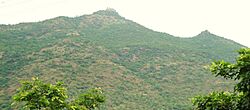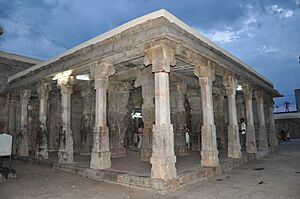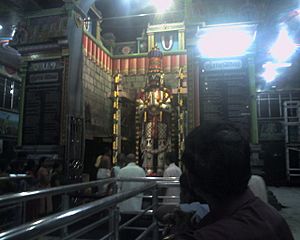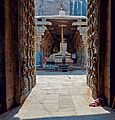Namakkal facts for kids
Quick facts for kids
Namakkal
Namagiri
|
|
|---|---|
| Nickname(s):
Egg City, Poultry Town, Transport Town
|
|
| Country | |
| State | |
| District | Namakkal |
| City | Namakkal |
| Named for | Namakkal Rock in the middle of the town |
| Government | |
| • Type | Mayor–council government |
| • Body | Namakkal City Municipal Corporation |
| Area rank | 78(2001), 93(2011) In state |
| Elevation | 218 m (715 ft) |
| Population | |
| • Total | 119,491 |
| Time zone | UTC+5:30 (IST) |
| PIN |
6370-01, (02, 03 ... 6370-12)
|
| Telephone code | 91 - 04286 |
| Vehicle registration | TN-28(North), TN-88(South) |
| Official language | Tamil |
Namakkal is a city in Tamil Nadu, India. It's the main city of the Namakkal district. Namakkal is special because it was the first city in Asia to get an ISO 14001-2004 certificate. This means it's really good at managing its environment. It handles things like water supply, waste, and city planning well. Namakkal is also known as the "Egg City" because it produces so many eggs. It's also called "Transport City" due to its busy transport industry.
Contents
History of Namakkal
Namakkal is a very old city, with its history going back to at least the 6th century. Its name comes from Namagiri. This is the name of a huge rock in the middle of the town. This rock is 65 meters (about 213 feet) tall and over a kilometer (about 0.6 miles) around! It is dedicated to Lord Vishnu.
There are two cave temples carved into this Namagiri hill. They are the Sri Narasimhaswamy Perumal Temple and the Sri Ranganatha Perumal Temple. People believe these temples were built around the 6th century CE. They were made by the Satyaputra Kings and Pandya kings using a special style called rock-cut architecture.
Historians have studied these temples. Some think they were built in the 8th century, while others believe it was the 6th century. The way they are built is similar to temples in Badami Caves from the 6th century. This suggests they might have been influenced by that style.
An old writing in the Ranganatha temple mentions it as Adiyendra Vishnu Grham. This shows that the cave was dug out by the Satyaputra Kings. A recently found inscription even names the king as Gunasila (around 500 CE). It's thought that both temples were built around the same time.
On top of this huge rock, there is a fort called Namakkal Fort. The Kongu nadu kingdom ruled Namakkal in the 16th century. Before that, during the Sangam age, Namakkal was part of the Kongu Nadu region ruled by the Cheras. It is believed that Tippu Sultan once hid in this fort to escape the British. He didn't build the fort, but he used it for a short time. Later, the British took control of the fort.
Namakkal was part of Kongu Nadu, a region that was often fought over by the ancient Pallavas and Pandyas. Over time, different powerful groups ruled Namakkal. These included the Cholas, Hoysalas, and Vijayanagara Kings. Then came the Madurai Nayaks, who built the Namakkal Fort. After them, the area was ruled by Muslim Sultans, Mysore kings, and the Marathas.
In the 1750s, Hyder Ali came to power. There was a big struggle between him (and later his son Tippu Sultan) and the British. The British captured Namakkal in 1768. For a while, Namakkal was part of the Tiruchirappalli district under British rule. Later, it became part of Salem District. Finally, on January 1, 1997, Namakkal became its own separate district.
Mahatma Gandhi held a public meeting in Namakkal in 1933. This meeting took place at the base of the Namakkal rock.
Population and People
| Religious census | ||||
|---|---|---|---|---|
| Religion | Percent(%) | |||
| Hindu | 88.98% | |||
| Muslim | 9.29% | |||
| Christian | 1.48% | |||
| Sikh | 0.01% | |||
| Buddhist | 0.0% | |||
| Jain | 0.01% | |||
| Other | 0.23% | |||
| No religion | 0.01% | |||
According to the 2011 census, Namakkal had a population of 55,145 people. There were 1,015 females for every 1,000 males, which is more females than the national average. About 5,002 children were under the age of six. The city's average literacy rate was 82.52%, which is higher than the national average. Most people in Namakkal are Hindus, followed by Muslims and Christians.
Places to Visit in Namakkal
Namakkal Anjaneyar Temple
The Namakkal Anjaneyar Temple is in Namakkal and is dedicated to the Hindu god Hanuman. It is built in the Dravidian style. The statue of Anjaneyar is 18 feet (about 5.5 meters) tall. This makes it one of the tallest Hanuman statues in ancient Indian temples. The statue was carved from a single stone and has been there since the 5th century. The temple does not have a roof over the main shrine. Anjaneyar is shown holding a sword and a garland of special stones called saligrama. This temple is considered very important in Tamil Nadu.
Namagiri Lakshmi Narasimhaswami Temple
The Namagiri Lakshmi Narasimhaswami Temple is dedicated to Lord Vishnu in his Narasimha form. People believe the Pandya kings built this temple in the 8th century. It is also a rock-cut architecture temple. Every year, a car festival for Lord Narasimmaswamy is celebrated in March and April.
Namakkal Fort
Namakkal Fort is a historic fort in Namakkal. It sits on top of a huge rock, which is 75 meters (about 246 feet) tall. Parts of the fort made of brick and stone still show signs of battles. The Cholas tried to capture the fort in the 9th century. The fort was made stronger by the kongu Vellalars in the 17th century. Inside the fort, there is a temple and a mosque, which are popular places for tourists to visit. Today, the Archaeological Department of the Government of Tamil Nadu takes care of the fort.
The Ranganathaswamy temple is another rock-cut temple near the fort. It is believed to have been built by the Pallavas.
Getting Around Namakkal
Road Transport
Buses from Namakkal travel to many cities in Tamil Nadu. These include Salem, Erode, Trichy, Karur, Coimbatore, Chennai, Madurai, and Dindigul. Namakkal is connected to the rest of India by National Highway 44. Buses going from Trichy or Madurai to Salem or Bangalore will pass through Namakkal.
Railway Transport
A new railway line connecting Salem to Karur through Namakkal opened on May 25, 2013. There are daily trains to and from Salem, Karur, Chennai Central, Bangalore, Dindigul, Palani, Madurai, Tirunelveli, Nagercoil, Pollachi, and Palakkad.
Here are some railway stations on the Salem to Karur line:
- Rasipuram railway station
- Puduchatram railway station
- Kalangani railway station
- Namakkal railway station
- Laddivadi railway station
- Mohanur railway station
And on the Salem to Erode line:
- Anangur railway station
- Cauvery railway station
Airports
The closest airports to Namakkal are:
- Salem Airport (52 km or about 32 miles away)
- Trichy International airport (85 km or about 53 miles away)
- Coimbatore International Airport (153 km or about 95 miles away)
Geography and Climate
Namakkal is located at 11.23°N latitude and 78.17°E longitude. It is about 218 meters (715 feet) above sea level. The city is close to the Kolli Hills, which are part of the Eastern Ghats mountain range. The nearest important river is the Kaveri River. Namakkal is about 360 km (224 miles) southwest of Chennai and 250 km (155 miles) south of Bangalore. Namakkal's twin town, Karur, is 34 km (21 miles) south across the Kaveri River.
The Kolli Hills are a prominent mountain range about 45 km (28 miles) from Namakkal. They are about 28 kilometers (18 miles) long from north to south and 19 kilometers (12 miles) wide from east to west. The Kolli Hills have been home to people since ancient times. They are mentioned in old Tamil literature. There is a Shiva Temple called the Arappalleeswarar Temple from the 12th century. It is near the Akasa Gangai waterfalls. An ancient and powerful deity called Kolli Paavai is also in the Kolli Hills. Many pilgrims visit this area.
Climate in Namakkal
Namakkal has a tropical savanna climate. This means it has a wet season from May to October. It also has a cooler season from November to February and a very hot season in March and April.
| Climate data for NMKL (Namakkal City) | |||||||||||||
|---|---|---|---|---|---|---|---|---|---|---|---|---|---|
| Month | Jan | Feb | Mar | Apr | May | Jun | Jul | Aug | Sep | Oct | Nov | Dec | Year |
| Record high °C (°F) | 32.8 (91.0) |
35.9 (96.6) |
37.3 (99.1) |
39.2 (102.6) |
48.9 (120.0) |
48.1 (118.6) |
38.3 (100.9) |
36.3 (97.3) |
30.3 (86.5) |
28.4 (83.1) |
27.7 (81.9) |
27.1 (80.8) |
48.9 (120.0) |
| Mean daily maximum °C (°F) | 27.9 (82.2) |
30.7 (87.3) |
33.1 (91.6) |
34.0 (93.2) |
33.3 (91.9) |
29.6 (85.3) |
28.3 (82.9) |
27.8 (82.0) |
28.6 (83.5) |
28.2 (82.8) |
27.2 (81.0) |
26.5 (79.7) |
29.6 (85.3) |
| Mean daily minimum °C (°F) | 15.8 (60.4) |
17.5 (63.5) |
20.0 (68.0) |
22.0 (71.6) |
21.7 (71.1) |
20.4 (68.7) |
19.9 (67.8) |
19.8 (67.6) |
19.8 (67.6) |
19.6 (67.3) |
18.0 (64.4) |
16.2 (61.2) |
19.2 (66.6) |
| Record low °C (°F) | 7.8 (46.0) |
9.4 (48.9) |
11.1 (52.0) |
14.4 (57.9) |
16.7 (62.1) |
16.7 (62.1) |
16.1 (61.0) |
14.4 (57.9) |
15.0 (59.0) |
13.2 (55.8) |
9.6 (49.3) |
8.9 (48.0) |
7.8 (46.0) |
| Average rainfall mm (inches) | 1.9 (0.07) |
5.4 (0.21) |
18.5 (0.73) |
41.5 (1.63) |
107.4 (4.23) |
106.5 (4.19) |
112.9 (4.44) |
147.0 (5.79) |
212.8 (8.38) |
168.3 (6.63) |
48.9 (1.93) |
15.7 (0.62) |
986.8 (38.85) |
| Average rainy days | 0.2 | 0.4 | 1.1 | 3.1 | 6.7 | 6.2 | 7.2 | 9.9 | 9.8 | 8.3 | 3.8 | 1.4 | 58.1 |
| Average relative humidity (%) | 60 | 52 | 30 | 43 | 60 | 72 | 76 | 79 | 76 | 73 | 70 | 68 | 63 |
| Mean monthly sunshine hours | 262.3 | 247.6 | 271.4 | 257.0 | 241.1 | 136.8 | 111.8 | 114.3 | 143.6 | 173.1 | 190.2 | 211.7 | 2,360.9 |
| Source 1: Indian Meteorological Department | |||||||||||||
| Source 2: NOAA (humidity and sun: 1971–1990) | |||||||||||||
Platinum Deposits
A small amount of platinum, about 0.7 tons, has been found in Sithampoondi village near Namakkal.
Images for kids
See also
 In Spanish: Namakkal para niños
In Spanish: Namakkal para niños




















